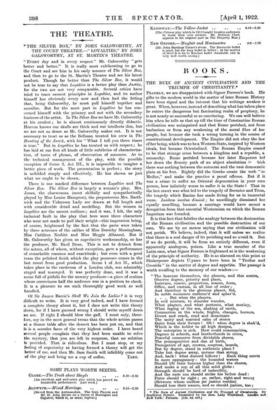THE THEATRE.
II THE SILVER BOX," BY JOHN GAISWORTIIY. AT THE COURT THEATRE.—" LOYALTIES," BY JOHN GALSWORTHY, AT ST. MARTIN'S THEATRE.
" EVERY day and in every respect " Mr. Galsworthy " gets better and better." It is really most exhilarating to go to the Court and see him in his early manner of The Silver Box, and then to go to the St. Martin's Theatre and see his latest product. Though far better than The Silver Box, it would not be true to say that Loyalties is a better play than Justice, for the two are not very comparable. Several critics have tried to trace earnest principles in Loyalties, and its author himself has obviously every now and then had the feeling that, being Galsworthy, he must pull himself together and moralize. But for the most part in Loyalties he has con- cerned himself with the primary and not with the secondary business of the artist. In The Silver Box we have Mr. Galsworthy at his crudest ; he is almost continuously directly didactic. Heaven knows our skulls are thick and our intellects dim, but we are not so dense as Mr. Galsworthy makes out. It is not necessary to treat us as the Bellman treated his crew in The Hunting 4 the Snark, with his " What I tell you three times is true." But in Loyalties he has treated us with respect ; he has laid at our feet all kinds of little subtleties of characteriza- tion, of turns of phrase, of observation of manners. As to the technical management of the play, with the possible exception of Scene 3, Act M., it is impossible to imagine a better piece of work. The presentation is perfect ; the story is unfolded simply and effectively. He has shown us just what we ought to be shown.
There is one marked difference between Loyalties and The Silver Box. The Silver Box is largely a woman's play. Mrs. Jones, the charwoman (most skilfully and sympathetically played by Miss Louise Hampton), the preposterous Mrs. Barth- wick and the Unknown Lady are drawn at full length and with considerable detail and modelling. But the women in Loyalties are the merest outlines ; and it was, I felt, the only technical fault in the play that here were three characters who were not made to pull their weight—this impression being, of course, heightened by the fact that the parts were taken by three actresses of the calibre of Miss Dorothy Massingham, Alias Cathleen Nesbitt and Miss Meggie Albanesi. But if Mr. Galsworthy has given us superlative workmanship, so has the producer, Mr. Basil Dean. This is not to detract from the actors, all of whom, without exception, gave a performance of remarkable resource and exactitude ; but even with a good team the polished finish which the play possesses comes in the last resort from good production. Scene 1 of Act IL, which takes place in the cardroom of a London club, was admirably staged and managed. It was perfectly done, and it was a scene full of pitfalls for the unwary producer—a piece of realism whose correctness half the audience was in a position to check. It is a pleasure to see such thoroughly good work so well handled.
Of Sir James Barrie's Shan We Join the Ladies ? it is very difficult to write. It is very good indeed, and I have formed a complete theory about it, but I dare not write this theory down, for if I have guessed wrong I should write myself down an ass. If right I should blow the gaff. I must only, there- fore, say in the most general terms that the whole action passes at a dinner tattle after the dessert has been put on, and that it is a macabre farce of the very highest order. I have heard several people complain that they had been unable to solve the mystery, that you are left in suspense, that no solution is provided. That is ridiculous. But I must stop, or my feeling of superiority at having formed a theory will get the better of me, and then Mr. Sam Smith will infallibly come out of the play and bring me a cup of coffee. TARN.


































 Previous page
Previous page